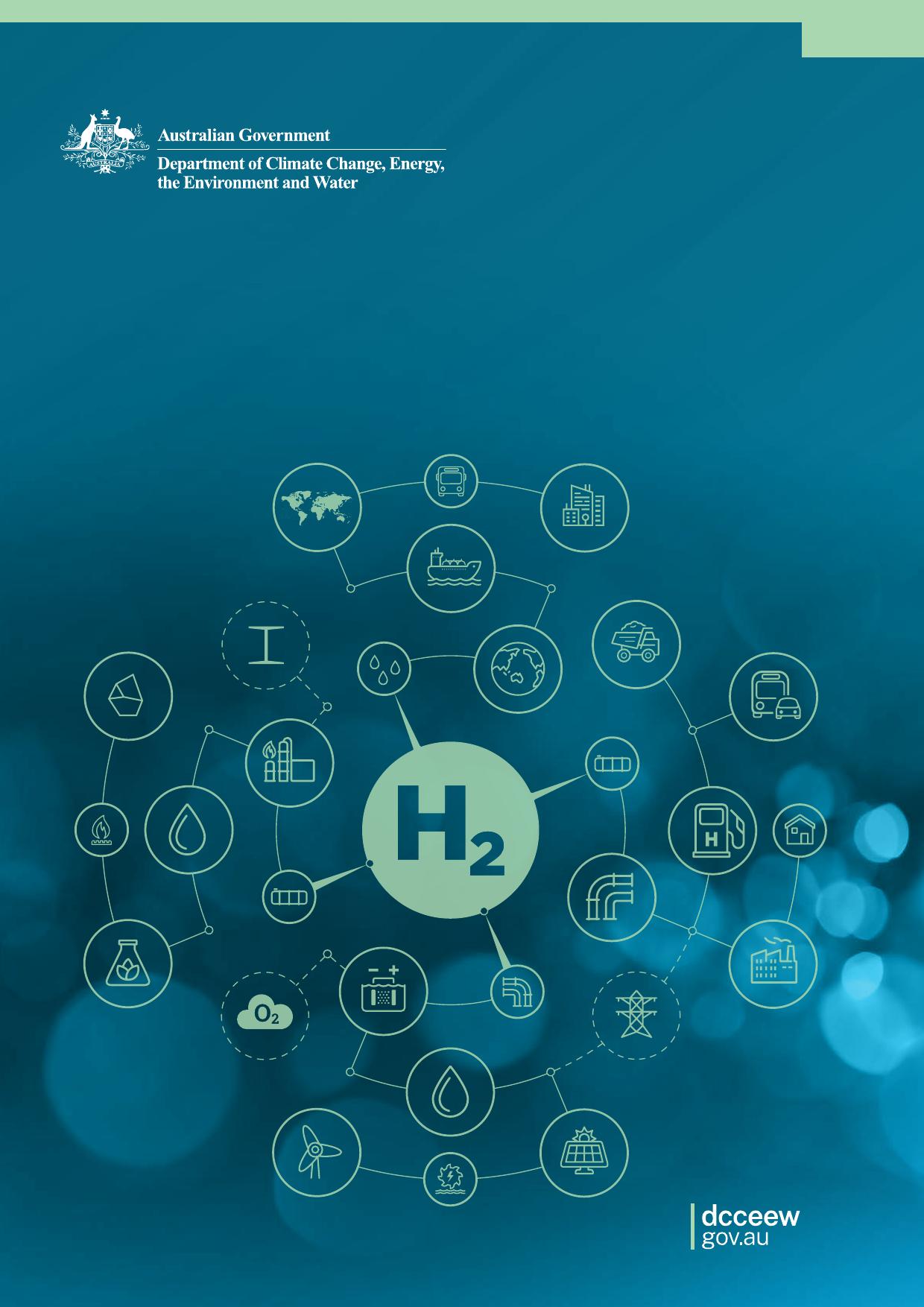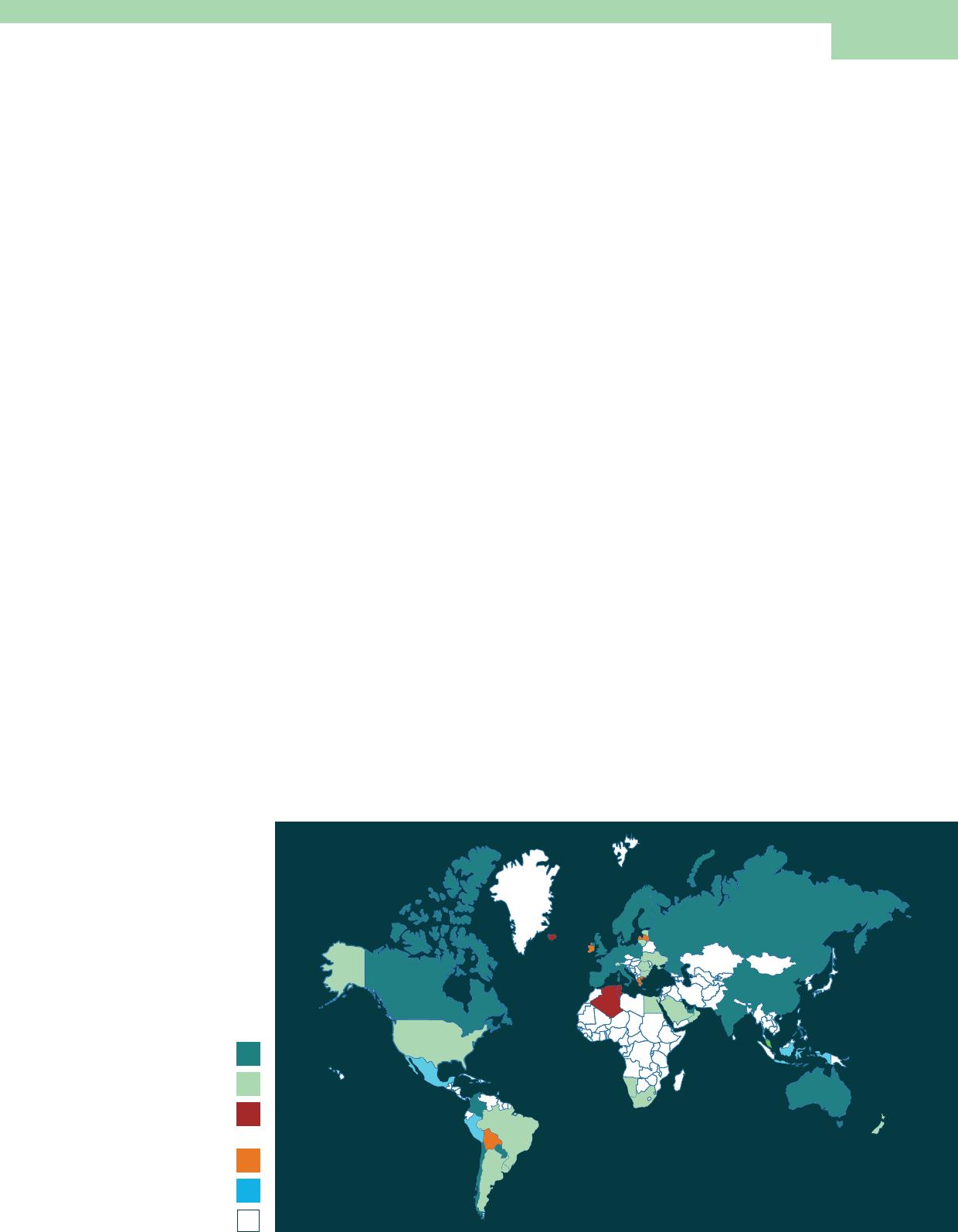NationalHydrogenStrategyReviewConsultationPaperIJuly2023HaveYourSaySubmissionstothisconsultationpapercanbemadeviatheDepartment’sConsultationHubandbyclickingthe“MakeaSubmission”button.•SubmissionsinrelationtotheNationalHydrogenStrategywillbesharedwiththeNHSReviewStatesandTerritoriesReferenceGroupestablishedtoassistwiththereviewoftheNationalHydrogenStrategy.•Submissionswillalsobepublishedonlineaftertheconsultationcloses,howeverstakeholdersmayrequestthatcomponentsoftheirsubmissionbekeptconfidentialandnotpublished.Thisconsultationwillcloseon18August2023.Copyright©CommonwealthofAustralia2023OwnershipofintellectualpropertyrightsUnlessotherwisenoted,copyright(andanyotherintellectualpropertyrights,ifany)inthispublicationisownedbytheCommonwealthofAustralia.CreativeCommonslicenceAttributionCCBYAllmaterialinthispublicationislicensedunderaCreativeCommonsAttribution4.0InternationalLicence,saveforcontentsuppliedbythirdparties,logos,anymaterialprotectedbytrademarkorotherwisenotedinthispublication,andtheCommonwealthCoatofArms.CreativeCommonsAttribution4.0InternationalLicenceisastandardformlicenceagreementthatallowsyoutocopy,distribute,transmitandadaptthispublicationprovidedyouattributethework.Asummaryofthelicencetermsisavailablefromhttps://creativecommons.org/licenses/by/4.0/Thefulllicencetermsareavailablefromhttps://creativecommons.org/licenses/by/4.0/legalcodeContentcontainedhereinshouldbeattributedasNationalHydrogenStrategyReview,ConsultationPaper,AustralianGovernmentDepartmentofClimateChange,Energy,theEnvironmentandWater.DisclaimerTheAustralianGovernmentasrepresentedbytheDepartmentofClimateChange,Energy,theEnvironmentandWaterhasexercisedduecareandskillinthepreparationandcompilationoftheinformationanddatainthispublication.Notwithstanding,theCommonwealthofAustralia,itsofficers,employees,oragentsdisclaimanyliability,includingliabilityfornegligence,losshowsoevercaused,damage,injury,expenseorcostincurredbyanypersonasaresultofaccessing,usingorrelyinguponanyoftheinformationordatainthispublicationtothemaximumextentpermittedbylaw.Norepresentationexpressedorimpliedismadeastothecurrency,accuracy,reliabilityorcompletenessoftheinformationcontainedinthispublication.Thereadershouldrelyontheirowninquiriestoindependentlyconfirmtheinformationandcommentonwhichtheyintendtoact.ThispublicationdoesnotindicatecommitmentbytheAustralianGovernmenttoaparticularcourseofaction.iNationalHydrogenStrategyReviewIConsultationPaperIntroductionAustralia’sfirstNationalHydrogenStrategywasendorsedbyallAustraliangovernmentsandpublishedin2019.TheStrategycontained57actionsandprinciplesoutliningtheinitialstepsAustraliacouldtaketodevelopalargescaledomestichydrogenindustry.Consistentwiththeadaptiveapproachtohydrogenindustrydevelopmenton24February2023,theEnergyandClimateChangeMinisterialCouncil(ECMC)agreedtoaReviewoftheNationalHydrogenStrategy(theStrategyReview)toensurethenationalstrategypositionsAustraliaonapathtobeaglobalhydrogenleaderby2030onbothanexportbasisandforthedecarbonisationofAustralianindustries.WhileAustraliawasthethirdnationtopublishahydrogenstrategyin2019,atleast30nationshavenowreleasedhydrogenstrategies,withmanymoreindevelopment.Thehydrogenindustryhasemergedfromtherelativefringestogenerateinternationalexcitementaboutthehydrogenopportunity.Internationalhydrogenmarketshaveshifteddramaticallyandwearelearningmoreaboutforwhichcurrentandemerginguseshydrogencanhavethebiggestdecarbonisationandeconomicimpact.Manyofthejurisdictionswithhydrogenstrategiesareimplementingfinancialincentivemechanismstoaccelerateinvestmentandindustrydevelopment.Figure1:NationalhydrogenstrategiesasofAugust16,2022AvailableInpreparationSupportforpilotanddemonstrationprojectsInitialpolicydiscussionsNoactivityNotassessedWhilepositivefortheemergenceofaglobalhydrogenindustry,theseinternationalactionspresentpotentialriskstoAustralia’shydrogenindustryintermsofincreasinglycompetitivesupplychains,thediversionofforeigninvestmentawayfromAustralia,andcompetitionforourpotentialhydrogen-basedexportindustries.The2022StateofHydrogenReport1foundthatAustraliaiswellplacedtoplayasignificantroleintheglobalhydrogenindustryduetoourrenewableenergypotential,skilledresourceandenergyworkforceandalonghistoryasatrustedenergyandresourcesexporter.2Australiahasaround40percentofallannouncedglobalhydrogenprojects,withtheAustralianpipelinevaluedfrom$230billionto$300billion.ThiswasconfirmedbytheREN212023GlobalRenewablesResourcesreportwhichfoundthat“Australiahadthelargestnumberofannouncedrenewablehydrogenplantsworldwideasof2022;duetoitsabundantsolarandwindresources,thecountryisexpectedtoseesomeofthelowestlevelisedcostsforproducingrenewablehydrogenby2050.3ˮHoweverbytheendof2022,onlyasingleAustralianprojectwithacapacityofatleast10MWhadreachedaFinalInvestmentDecision(FID).Thiscomparestoalmost1400MWofcapacityintheEuropeanUnion,and300MWofcapacityintheUnitedStates,ofsuchprojectstoreachFID.1DCCEEW(2023)StateofHydrogen2022Reportatwww.dcceew.gov.au/energy/publications/state-of-hydrogen-20222DCCEEW(2023)StateofHydrogen2022Reportatwww.dcceew.gov.au/energy/publications/state-of-hydrogen-20223REN21(2023)GlobalRenewableResourcesreport.ren21.net/wp-content/uploads/2019/05/GSR-2023_Energy-Supply-Module.pdfFigure2:ThedevelopingrationaleforaworldleadinghydrogenindustryWorldclassenergyresourcesDecarbonisationopportunity$300billionprojectpipelineAdvancingexportcompetitioniiiNationalHydrogenStrategyReviewIConsultationPaperCompoundingthedisparitybetweentheprogressofhydrogenprojectsgloballyisthecreationofnew,extensivepolicymeasuresinothercountriestosupportthedevelopmentoftheirdomestichydrogenindustries.TheInflationReductionActintheUSisthemostnotable,providing,tradeabletaxcreditsforhydrogenproductionthatcanbecombinedwithtaxcreditsforrelatedrenewableenergyproductionandendusecases.Anumberoflargeeconomieshaverespondedwithsimilar,albeitnotquiteasextensive,supportmechanisms.So,whileAustraliahasthefoundationstobeaglobalhydrogenleaderthereisaneedtoconsiderupdatedoradditionalactionstoensureAustraliareachesitspotential.TheAustralianGovernmenthastakenastepinannouncingtheestablishmentofa$2billioncompetitivehydrogenproductioncontractprogram.HydrogenHeadstartwillfocusonsupportingthescalinguphydrogenproductionusingrenewableelectricitywhichwillinturnhelpreducethecostofthistechnologyovertime.ThisacknowledgesAustralia’svastrenewableenergyresourcesandsupportstheGovernmentsambitiontobearenewableenergysuperpower.DetailedconsultationonthedesignfeaturesoftheHydrogenHeadstartprogramwillbethroughaseparateconsultationprocess.Thispaperseekssubmissionstoassistthereviewofthe2019Strategy.Thepaperprovidescommentaryandposessomespecificquestions,theresponsestowhichwillassistthepreparationofarevisedStrategy.Inaddition,respondentstothepapershouldnotetherevisedStrategy’sthreestrategicobjectivesbelow.StrategicObjective•Australiaisonthepathtobeaglobalhydrogenleaderby2030•Enabledomesticdecarbonisationthroughthedevelopmentofthehydrogenindustry•EnsureeconomicbenefitforallAustraliansthroughthedevelopmentofthehydrogenindustry.Unlessotherwiserequested,thesubmissionswillbepublishedonlineinfull,andprovidedtoStatesandTerritoriesinadvanceofpublicationtosupportthereviewofthehydrogenstrategiesofindividualjurisdictionsandtheirengagementintheNationalHydrogenStrategyReview.ivNationalHydrogenStrategyReviewIConsultationPaperContentsNationalHydrogenStrategy01HowcanAustraliaenabledecarbonisationthroughthedevelopment01ofacleanhydrogenindustry?HowcouldAustraliafurtheractivateitshydrogenand07relatedindustries?Howcanweensureourhydrogenindustryattractsthenecessary12investment?Howcanweensureourhydrogenindustrydevelopsinaway14thatbenefitsallAustralians?Howshouldwedevelopthenecessaryinfrastructureneededto16supportthedevelopmentofourhydrogenindustry?Howcanweenableahydrogenexportindustry(includingthe18exportofgoodsmanufacturedwithhydrogen)?Otherfeedback19AppendixA2019Summaryofconsultationmatters21AppendixB2019NationalHydrogenStrategyActions211NationalHydrogenStrategyHowcanAustraliaenabledecarbonisationthroughthedevelopmentofacleanhydrogenindustry?4Advisian(2021)AustralianHydrogenMarketStudyatwww.cefc.com.au/media/nhnhwlxu/australian-hydrogen-market-study.pdf,AustralianGovernment(2021)Australia’sLongTermEmissionsReductionPlan-Awhole-of-economyPlantoachievenetzeroemissionsby2050athttps://unfccc.int/sites/default/files/resource/Australias_LTS_WEB.pdf,CSIRO(2023)Hydrogen–Fuels–EstimatedEmissionReduction–CSIRO,ARENA(2023)IndustrySetsPathtoNetZero–MediaReleaseathttps://arena.gov.au/news/industry-sets-a-path-for-net-zeroTherevisedNationalHydrogenStrategywillbuilduponthe2019StrategyandfocusontherolehydrogentechnologyneedstoplayforAustraliatomeetitscommitmenttoachievenetzeroemissionsby2050andtoreducegreenhousegasemissionsby43%below2005levelsby2030.StateandterritoryjurisdictionshavealsostatedtheirownaspirationstowardsaNetZeroemissionstarget.Hydrogenwillcontributebetween10%to33%towardsglobalandAustralianemissionsreduction4.Fortunately,hydrogencanbeusedinmultipleapplicationsandwillbeparticularlyimportantforhard-to-abatesectorswhichcannotbeeasilyelectrified.EmissionsreductionapproachesGeneratingrenewableelectricityAdoptingelectricmachinery,vehiclesandappliancesNotwastingenergyResearchinganddevelopinghowtofurtherreduceemissionsTechnologyEnergyEfficiencyElectrificationDecarbonisationFigure3:Hydrogen(Technology)providesanemissionsreductionopportunity(SourceAnnualClimateChangeStatement2022)2NationalHydrogenStrategyReviewIConsultationPaperAmmoniaproduction–DomesticandExportAustraliaalreadyhasalarge,announcedinvestmentpipelineof35greenammoniaorotherhydrogenchemicalderivativeexportprojectsworthover$150billion.ThenumberoftheseproposedprojectsinthissectordoubledinAustraliainthelastyearandafinancialinvestmentdecisionwasreachedonthefirst10MWelectrolyserprojectinAustralia.EnergysecurityissuesarisingoutofEuropehavemeantthatforperiodsin2022,greenammoniapriceswereincreasinglycompetitive.Bothfuelsecurityconcernsanddecarbonisationambitionisgeneratingstrongnear-terminterestfromJapanandSouthKoreatoimporthydrogenchemicalderivativeslikemethanolandammoniaandfromAustralia.Decarbonisingexistingammoniaproductionprovidesarelativelystraightforwardopportunitygiventheindustryalreadymakesdirectuseof425,000tonnesofhydrogenperyearproducedfromunabatedfossilfuels.Currentdomesticproductionforboththeminingexplosivesandagriculturalsectorresultsinapproximately4milliontonnesofcarbondioxideemissionsperannum.Figure4:LocationofSafeguardFacilitiesandpotentialtousehydrogen(SourceDCCEEWanalysis)LikelyuserofhydrogenBellBayHubHunterHubGladstoneHubPilbaraHubKwinanaHubPtBonythonHubPossibleuserofhydrogenLocationandscale(greyhydrogenproduction)37%30%33%3NationalHydrogenStrategyReviewIConsultationPaperInadditiontoadirectreductionincarbonemissions,alarge-scaleswitchwithinthisindustrywouldalsoproducearapidimprovementinthevolume-driveneconomicsforAustralia’spipelineofhydrogenproductionprojects,ofwhichover35arefocusedonmakingammoniaforbothdomesticuseandexport.Thislargeswitchcouldalsode-riskinvestmentinadomesticelectrolysermanufacturingsectorbecausethisshiftwouldultimatelyrequireintheorderof7,000megawattsofelectrolysis.Bycomparison,attheendof2021,thecumulativeinstalledcapacityofelectrolysersworldwidewas513megawatts.5Industrialprocessheat–DomesticAustralianindustryaccountsfor44%ofthenation’senduseenergy,halfofwhichisusedintheproductionofprocessheat,primarilythroughthedirectcombustionoffossilfuels6.Hydrogencanreplacenaturalgasforindustrialprocess,particularlywhereheatisrequiredatmediumtohightemperatures.Thisincludesasareplacementfornaturalgasforindustrialheatingpurposesinironpelletproduction7,aluminarefining8andfoodprocessing9.Switchingtorenewablehydrogencalcinationinaluminarefiningwouldsave3.5MtCO2ep.a.Together,thiswouldaccountfor23.7%ofAustralia’semissionsfromindustrialprocessesandproductuseortheequivalentoftaking1.6millioncarsoffAustralia’sroadseachyear.10”Electricitygridfirming–DomesticHydrogencanalsoplayakeyroletosupportthedecarbonisationandtransformationofnationalelectricitygridsthroughcreatingschedulableload,storingenergywhengenerationisinsurplusandmakingitavailabletohelpmeetpeakelectricitydemand11.Thisapproachisparticularlysynergisticwithintermittentrenewableelectricitygeneration.Australiaisconsideredarelativeleaderintheuseofhydrogenforgridfirming,consideringtheearlydevelopmentoftheSouthAustralianGovernment’s200MWhydrogen-firedpowerstationinWhyalla,theTallawarraBgasgeneratorunderconstructionandtheHunterPowerProject.5Dr-Alan-Finkel-AHRC-2023-Presentation-Speech.pdf(ahrc2023.com.au)6Lovegrove.K(2019)https://arena.gov.au/assets/2019/11/renewable-energy-options-for-industrial-process-heat.pdf7HyResource(2023)GrangeResourcesRenewableHydrogenStudy.CSIROathttps://research.csiro.au/hyresource/grange-resources-renewable-hydrogen-study8RioTinto(2021)MediaRelease-Rio-TintoandSumitomotoassesshydrogenpilotplantatgladstonesyarwunaluminarefinery9PVMagazine(2023)Industry-firstpilotusinghydrogeninfoodmanufacturinglaunchesinNSW10Deloitte(2023)TheHydrogenTippingPoint11HyResource(2023)SouthAustralianGovernmentHydrogenFacility–HyResource(csiro.au)4NationalHydrogenStrategyReviewIConsultationPaperTransport-DomesticandInternationalHydrogenisalreadyusedinthetransportsystemsofothercountriesandoffersadvantagesintermsofweight,powerdensity,range,andrefuellingtimes.Thesecharacteristicsareparticularlyvaluabletoheavycommercialvehiclesincludingtrucks,forklifts,miningvehicles,buses,trains,andmarineshippingandferries12.Australianfirmsarealreadymanufacturingandtestingthefirsthydrogenbuses.Hydrogentrucksandminingtruckscouldhelpsupportdecarbonisationoftheheavyroad-transportsectorthatcontributescloseto40%oftheAustraliantransportsector’sgreenhousegasemissions.Australianfirmsarealsoleadingglobaldesignersofhydrogenferries.Marineindustry–bunkering–DomesticandInternationalCurrently,Australia’ssupplyoffueloilforinternationalmaritimeshippingismuchsmallerthanAustralia’sshareofseaborneinternationalcargo(byweight).Thisreflectsthepracticeofbunkeringatportswithlowercostsuppliesoffueloil.Themaritimesectoristakinglargestepstowardsdecarbonisingitsoperations13.Inafutureinwhichshipsarepoweredbyhydrogen(oranequivalentderivativesuchasammoniaormethanol),thispracticemaychangewithbunkeringoccurringinAustraliatotakeadvantageoflow-costproductionofhydrogen.Forinstance,in2022,YaraCleanAmmoniaandPilbaraPortsAuthority(PPA)signedaCollaborationAgreementtojointlyfacilitatetheuptakeofammoniaasamarinefuelinthePilbararegioninWesternAustralia.ReplacementofdieselgeneratorsManyresourceminingandremotecommunitiesinAustraliarelyondieselornaturalgasgeneratorsfortheirelectricitysupply.StudiesbyCSIROandAdvisian14notethathydrogenhasreachedpriceparitywithbattery-dieselhybridsystemsinremotepowerservices.Replacingdieselwithhydrogenpresentsaclearnear-termopportunityandoffershealthandairqualitybenefitsandpotentialsynergieswithassociatedheavyvehiclefleets.Australianstart-upsareinnovatinginthisspacecreatingnewdomesticmanufacturingopportunities.AswellasreplacingdieselgeneratorsinruralandremoteAustralia,suchtechnologiescouldalsohelpPacificIslandsandpartsofASEANnationstransitionfromdieselgeneratorstocleanhydrogengeneratorsandorcleanhydrogenembeddedintorenewablemicro-grids.Internationallyanddomesticallyhydrogenisalreadybeingusedinmicro-gridprojectsforcivilianandDefenceapplications.12SamplesofAustralianhydrogenferrydesignexpertise-Future-readyFastFerries:DevelopingpathwaystoZeroEmissionsAustal:CorporateandAustaltodesignhydrogenpoweredcatamaranferry-AustralianManufacturingForum(aumanufacturing.com.au)andGotlandpicksAustaltodesignworld’sfirstlargehydrogencatamaranTradeWinds(tradewindsnews.com)13Forexamplehttps://climatechampions.unfccc.int/green-hydrogen-and-green-shipping/andMaritimeindustryjoinsforceswithleadingglobalminersinsupportofAustralia-EastAsiaironoreGreenCorridor(riotinto.com)14Advisian(2021)AustralianHydrogenMarketStudyatwww.cefc.com.au/media/nhnhwlxu/australian-hydrogen-market-study.pdf5NationalHydrogenStrategyReviewIConsultationPaperSustainableaviationfuels–DomesticandExportAviationfuelforlongdistanceflightsisregardedasahardtoabatesector.Tomakejetfuel,ittakes,twoelements–carbonandhydrogen.Thecarboncanbeextractedviacarboncaptureandutilisationfromindustrialprocessesorfromtheairusingdirectairremovalandthehydrogenextractedfromwater.Theendproductisnormallyreferredtoassyntheticjetfuel.Itcanbeshippedtointernationalcustomersatmuchlowercostthanthefeedstocks.ThekeyforAustraliaisachievingultra-lowcostrenewablegeneration,atvastscale,topowerthedirectaircaptureequipmentandtheelectrolysers.GreenIronandSteelproduction-DomesticandExportAstheworld’slargestironoreproducer,Australiacanplayasignificantroleintransitioningsteelmakingtoanet-zeroemissionsindustry(currentlyaround7%ofglobalemissions).Australiaexportsalmost900milliontonnesofironoreeachyear,butonlyproduces5.5milliontonnesofsteel.Thereisthepotentialtoestablishanewonshoregreenironoreandsteelprocessingindustry,utilisingrenewableenergyandhydrogentovalue-addtooursignificantironoreexports.AnAustraliangreenironindustrycouldreduceglobalemissionssignificantlywhilecreatingnewhigh-qualityjobsinAustraliaandattractingincreasednationalrevenueandinternationalinvestment15.Agricultureandfoodsectors–DomesticandExportInternationallyprogressisbeingmadetoutilisecleanhydrogentohelpdecarbonisetheagricultureandfoodsectors.Hydrogenfuelcellscanbeusedtopowerfarmequipmentandmachinery.Japanesemulti-nationalKubotaplanstorolloutamass-producedhydrogenfuelcelltractorin2025.Awiderangeofresearchersandcompanies16aredemonstratingthathydrogencanbeusedalongsidecarbondioxideandnaturalbacteriatoenableprecisionfermentationtocreateclosetocarbonneutralproteinfood,withthepotentialtoformafoodproductsubstituteforpalmoilandsoy,animallivestockproteinfeed17,andmanytypesofconsumerfoodproductsandbiomaterials18.CSIRO’s2022NationalProteinRoadmappredictsthatby2030,Australiacouldrealisticallyproduce225,000tonnesoffinishedprecisionfermentation19microorganism-basedproteinproducts,worthA$2.2billionatretailand2,020jobsby203020.Theglobalmarketforalternativelowercarbonproteinsisforecasttobeworthasmuchas$290billionby203521.15ModellingbyAccentureindicatesthepotentialdevelopmentofgreenironandsteelsectorinAustraliacouldcreate$35.3billioninexports,$20.1billionindirectandindirectvalueaddandcreateuptoapproximately111,000directandindirectjobsby2040.16SolarFoods-Home-SolarFoodsandSolarFoodsreceivesnovelfoodregulatoryapprovalforaproteingrownwithCO2,hydrogenandelectricity-SolarFoodsAirProteinAirProteinAnnounces$32MillionSeriesAFunding-SynBioBeta17DeepBranch-DeepBranch–Cleaningredientsforclimate-friendlyfoodwhichhasbeenpromotedbytheWorldEconomicForumatThisstart-uprecyclesCO2andhydrogenintoanimalfeedWorldEconomicisfocusedonthisapplicationofcreatinglowcarbonlivestockproteinfeedusinghydrogenasoneoftheingredients.18ThecompanyKiverdiusesall-naturalmicrobestotransformcarbondioxideandhydrogenintohigh-valuedproteinfood,nutrients,andbio-basedmaterials.KiverdiBio-BasedIndustriesConsortium(biconsortium.eu)19CSIRO(2021)PrecisionFermentation–ScalingtheNextManufacturingRevolutionandCSIRO–PrecisionFermentation20CSIROFutures(2022)Protein-ARoadmapforunlockingtechnology-ledgrowthopportunitiesforAustralia21BostonConsultingGroup(2023)Alternative-ProteinMarkettoReachatLeast$290Billionby2035(bcg.com)6NationalHydrogenStrategyReviewIConsultationPaper1.Isprioritisingthedecarbonisationofammoniaproductionthemostprospectivewaytoachievebothhydrogenindustrygrowthandindustrialdecarbonisationintheshort-term?2.Whatotheractionsintheothersectors,willhavethegreatestdecarbonisationimpacts?3.Whatsectorsarebestplacedtobeearlyadoptersofhydrogen?4.Aretherespecificbarriersthatmaylimithydrogenuptakeuptakeineachofthesesectors?Forexample:arethereparticularinfrastructureneedstoenablehydrogentocontributetogridresilience?Isspecificregulationneededtoensurehydrogencanassistinthedecarbonisationoftheheavytransportsector?IsfurtherplanningneededbeforeAustralianportscanincreasetheirshareofbunkeringforinternationalshipping?Or,arespecificincentivesneededtorapidlyswitchtohydrogenpoweredgeneratorsatremotecommunityandminesites?5.Whataretheactionsrequiredtoovercomethosebarriersandrealisetheopportunities?Forinstance,whatsupplychainrisksneedtobeaddressedandovercome?7NationalHydrogenStrategyReviewIConsultationPaper7HowcouldAustraliafurtheractivateitshydrogenandrelatedindustries?22DCCEEW(2023)StateofHydrogen2022Reportatwww.dcceew.gov.au/energy/publications/state-of-hydrogen-2022The2019Strategysupportedthehubmodelasanearly-stageapproachtoachievethescaleneededforacompetitiveindustry.Hydrogenhubsareintendedtomakethedevelopmentofsupplychaininfrastructuremorecost-effectivebyaggregatingvarioususersofhydrogenintoonegeographicalarea.PlansforhydrogenhubsarealsobeingprogressedinternationallyforexampleintheUnitedStates,UnitedKingdom,Germany,theNetherlands,JapanandIndia.TheAustralianGovernmentisinvestingoverhalfabilliondollars,andthestatesandterritorieshavecommittedover$400million,tosupportthedevelopmentofregionalhydrogenhubsacrossAustralia.AnalternativetotheHubmodelwouldbetotargethigh-impactsectorswhichofferthegreatestpotentialtoscaleupquickly,providesubstantialdecarbonisationorprovidesignificanteconomicgain.Forexample,theAustralianGovernmentisalreadyworkingwithstatesandterritoriestohelpdecarboniseheavytransportthroughHydrogenHighwaysandrelatedinitiatives,andisconsultingonthedesignofthe$2billionHydrogenHeadstartprogramthatisnotspecificallytargetinghydrogenproductionprojectsinahydrogenhubwhereotherproducersandusersarecollocated.6.ShouldAustraliangovernmentsadoptamoresectordrivenapproachtohydrogenindustrydevelopment?TargetsandmandatesNationalhydrogentargetswerenotconsideredimmediatelynecessaryin2019,withthe2019Strategyflaggingtargetsasafutureoptionasthemarketforhydrogendevelops.Targetsandmandatescantakemanyformsandprovidetheindustrywithconfidenceofthefuturemarketplaceforhydrogen.TheEuropeanUnion,UnitedKingdomandtheNetherlandsallincreasedtheirhydrogenproductionambitionsin2022.JapanandKoreahaveintroducedaspirationaltargetsforanexpandedroleforammoniafuelby2030.Bothregulatedandaspirationaltargetscanbenefitindustrydevelopmentbysignallinggovernmentand/orindustryambitiontobolsterinvestorconfidence.InJune2023,theKoreaH2BusinessSummit,comprisingprominentcompaniessuchasHyundaiMotorGroup,SKGroup,PoscoGroup,andLGChem,announcedgoalsofachievingmorethan10percentcarbonemissionreductionsthroughhydrogenby2030.Othercountrieshavealsointroducedtargetsfortheuseofcleanhydrogeninindustryandforthetransportsector(refer2022StateofHydrogenReportTable1222).8NationalHydrogenStrategyReviewIConsultationPaperWithoutsufficientdemand,hydrogenproducerswillbeunabletolockinoff-takersandsecureinvestmenttoscaleupproduction.Forexample,theNSWgovernment’srenewablefuelschemeisbasedaroundahydrogenproductiontargetandrequiresgasretailersandlargeuserstobuycertificatesassociatedwiththeproductionofhydrogeninordertoachievethetarget.Someexpertssuggeststartingwithasectoraltarget,whichfocusesonswitchingoverexistingusesofhydrogeninAustralia,suchasammoniaproduction,tocleanhydrogenandhavingarealistictargetdateandpackagetosupportthattransition23.ThiscouldnotonlydrivegreatercleanhydrogeninvestmentbutalsocreatesufficientdomesticdemandinAustraliathatitcouldalsode-riskgreaterinvestmentinelectrolysermanufacturinginAustraliatoo.IndiaandsomeEuropeannationshavesignalledtheirintentiontoadoptmandatoryquotasfortheuseofcleanhydrogenbyindustry,andEuropeannationshaveagreedtobuildhydrogenfuellingstationsinallmajorcitiesandatleastevery200kilometresalongthecoreTrans-EuropeanTransportNetwork,ensuringasufficientlydensenetworktoallowhydrogenvehiclestotravelacrosstheEuropeanUnion.23Finkel,A(2023)KeynoteAddress–AustralianHydrogenResearchConferenceatDr-Alan-Finkel-AHRC-2023-Presentation-Speech.pdf(ahrc2023.com.au)Figure5:SummaryofinternationalhydrogenpolicymeasuresAustraliaUSACanadaJapanKoreaIndiaEUGermanyChinaNetherlandsUKFranceSpainChileProductionTargetDemandTargetProductionincentiveschemeProjectfunding(grants)Net-zerotargetlegislated9NationalHydrogenStrategyReviewIConsultationPaperIndia’sNationalHydrogenMissionIn2021,PrimeMinisterNarendaModiannouncedIndia’sNationalHydrogenMission.India’sHydrogenMissionseekstotransformIndiaintoaglobalgreenhydrogenproductionhub.ThetargetoftheHydrogenMissionistoproduce5milliontonnesofgreenhydrogenby2030.Inordertocreatebulkdemandandscaleupgreenhydrogenproduction,theIndianGovernmentwillspecifyaminimumconsumptionshareofgreenhydrogenoritsderivativeproductsasenergyorfeedstock.AlegalprovisionforensuringenforceabilityofconsumptiontargetsforgreenhydrogenanditsderivativeswillbeestablishedthroughtheEnergyConservationAct,whichwillempowertheIndianGovernmenttospecifytheminimumshareofenergyandfeedstockconsumptionfromnon-fossilfuelbasedsourcesthatanindustrymustensure.7.ShouldAustraliangovernmentsadoptnationalhydrogenproduction,useand/orexporttargetsforhydrogen?8.Iftargetsareadopted,whattypeofactivitiesand/orsectorsshouldthistargetbetailoredtowards?Forexample,productiontargets,demandtargetsforsectorssuchastransportorarenewablegastarget.Pleasedescribehowsuchtargetswouldattractinvestment.9.ShouldAustraliangovernmentsuseregulatorymandatestodrivedemandforhydrogen?Ifmandateswereadopted,whattypeofactivitiesand/orsectorscouldmandatesbedirectedtowards?Pleasedescribehowsuchmandateswouldattractinvestment.AddressingSupplyChainRisksThe2019Strategysupportedearlyactionstodevelopcleanenergysupplychainstoservicenewandexistingusersofhydrogenandtodevelopcapabilityforrapidindustryscale-up,includingskillsandtrainingforthehydrogeneconomy.ThefinancialincentivesprovidedbytheUnitedStatesInflationReductionAct,aswellasthosebeingimplementedbyothercountriesinresponsetotheUnitedStates’actions,willputnear-termpressureonalreadyconstrainedsupplychains,potentiallyresultinginhighercostsorprojectdelays.Overtime,growingglobalinvestmentisexpectedtoscaleindustrydevelopment,expandingsupplychainsandultimatelybringingdowncosts.Australia’sdevelopmentofahydrogen-readyworkforceiscriticalgivenourscaleofambition.Understandingtheextenttowhichexistingqualificationsneedtobealteredandwhetherentirelynewcoursesarerequiredisanimportantfirststep.Beyondthatstep,theworkforcenumbersandoccupationsrequiredwillbenecessaryinformationtoplanforthegrowthofthesector.TheAustraliangovernmentiscurrentlyscopingtheexistingandplannedworkforcepoliciesandinitiativesasafirststeptobuildingAustralia’sfutureenergyworkforce.10NationalHydrogenStrategyReviewIConsultationPaperThegovernmentisalsoconductingacomprehensivereviewofAustralia’smigrationsystemtoensureitbettermeetsexistingchallengesandsetsacleardirectionforthecomingdecades.ThenewNationalNetZeroAuthority24willalsosupportworkersinemissions-intensivesectorstoaccessnewemployment,skillsandsupportasthenetzerotransformationcontinues.10.WhatarethemostsignificantsupplychainbarriersbeingfacedbyAustralia’shydrogenindustry?WhereshouldAustraliangovernmentsfocuseffortsonsecuringelementsofsupplychainsneededtoenabletheacceleratedgrowthofthehydrogensector?11.ShouldAustraliadevelopandsupportlocalmanufacturingcapabilitiestosecurethehydrogensupplychain?Whatarethespecificareasofopportunity(e.g.fuelcellorelectrolysermanufacturingorhydrogentransportationrelatedmanufacturing)?12.Whatarethebarrierstodevelopingandsupportinglocalmanufacturingcapabilities?13.Whatistheroleofindustryandgovernmentstoensurethehydrogenindustryhasaccesstoanappropriatelysizedandskilledworkforce?Timelyaccesstoelectrolysersandfuelcellsisgoingtobecriticaltocreatingandsustainingagloballyleadingcleanhydrogenindustryfrom2030inAustralia.AsillustratedinFigure9ofthe2022StateofHydrogenReport25,accordingtotheprojectpipelineto2030,theInternationalEnergyAgency’sforecastsatotalglobalelectrolysercapacityof130GWby2030,including30GWofelectrolysercapacityinAustralia.Thescaleofdemandforelectrolysersandassociatedrenewableenergybetweennowand2050todeliverthequantumofrenewablebasedhydrogenneededfornationstoachievetheirnetzerotargetsissignificant.Producingallofthededicatedhydrogenoutputin2019(69MtH2)fromelectricitywouldresultinanelectricitydemandof3,600TWh,morethanthetotalannualelectricitygenerationoftheEuropeanUnion.ToreachIRENA’sprojectionforhydrogenuseby2050ina1.5°Cscenariosome5,000GWofhydrogenelectrolysercapacitywouldbeneeded,upfrom0.3GWin202226.Theelectricityrequiredtoproducethisscaleofhydrogenin2050reachescloseto21,000TWh,almostthelevelofglobalelectricityconsumptiontoday.AustraliaandthebroaderIndo-Pacificregionisanticipatedtocompriseroughly21%ofglobalhydrogendemandin2050.Inthiscontext,FortescueFutureIndustrieshasinvestedinanelectrolysermanufacturingplantinGladstone.Hysata’sworkwithFraunhoferIPTindevelopinganewcapillaryledelectrolysertodeliverlow-costhydrogeninPortKemblaisalsoanexampleofhowAustraliancompaniescandevelopinnovativeelectrolysertechnologyandIP.24NationalNetZeroAuthorityPrimeMinisterofAustralia(pm.gov.au)25DCCEEW(2023)StateofHydrogen2022Reportatwww.dcceew.gov.au/energy/publications/state-of-hydrogen-202226IRENA(2022)GeopoliticsoftheEnergyTransformation–TheHydrogenFactor11NationalHydrogenStrategyReviewIConsultationPaperThemarketisintheearlystageoftheelectrolysermanufacturinglearningcostcurveswithsignificanttechnicalopportunitiesavailabletoimprovetheirenergyefficiencyinwaysthatcanreducebothCAPEXandOPEX.Electrolysersarecomplex,withcoolingsystems,waterde-ionisingandpumping,gasseparation,electricpowerconditioning,safetymonitoring,dehydratingsystemsandmore.So,itwillbeimportanttohaveaskilledelectrolyserworkforce.Thecombinationofsupplychainbottleneckrisks,thehighcostsofimportingelectrolysersandtheneedforahighlyskilledelectrolyserworkforceindicateanopportunityforindustryandAustralianGovernmentstoencouragethecreationofadomesticelectrolysermanufacturingsector27.ThepotentialmarketforelectrolysersinAustraliaissignificant,whichcouldunderpinadomesticelectrolysermanufacturingsector.TheAustralianGovernment’sNationalReconstructionFundandPoweringtheRegionsFundprovideaopportunitytosupportthistypeofdomesticindustrytodevelop.Fuelcellmanufacturingis,bycomparisonwithelectrolysermanufacturing,alotmoreadvancedoverseas.However,fuelcellsarealsogenerallyatmost60%energyefficientsuggestingpotentialtechnicalinnovationandimprovementispossible.TherecouldalsobeacaseforinvestinginfuelcellR&D&Dtoimprovefuelcellefficiency,andthenalocalfuelcellmanufacturingsectoraspartofstrategicallypositioningAustraliaforlongtermglobalcleanhydrogenindustrycompetitiveness.14.Inadditiontoelctrolysers,wheredoyouseearolefordomestichydrogenrelatedmanufacturingtoaddresssupplychainrisksandensureAustraliameetsitsdecarbonisationtargetssuchashydrogenbuses/heavyvehicles?27Finkel,A(2023)KeynoteAddress–AustralianHydrogenResearchConferenceat-Dr-Alan-Finkel-AHRC-2023-Presentation-Speech.pdf(ahrc2023.com.au)12NationalHydrogenStrategyReviewIConsultationPaperHowcanweensureourhydrogenindustryattractsthenecessaryinvestment?28Green'HydrogentoOutcompete'Blue'Everywhereby2030BloombergNEF(bnef.com)29Deloitte(2023)Greenhydrogen:Energizingthepathtonetzeroatwww.deloitte.com/content/dam/assets-shared/docs/gx-deloitte-green-hydrogen-report-2023.pdf30DCCEEW(2023)NationalHydrogenInfrastructureAssessmentatwww.dcceew.gov.au/sites/default/files/documents/Australiahasasubstantialpipelineofannouncedprojects,intheorderof$230-$300billion.However,Australialagsbehindothernationsinconvertingannouncementsintofinalinvestmentdecisions.Thesignificantcostgapbetweenrenewablehydrogenandhigh-carbonalternativesisamajorbarriertoadvancingAustralia’shydrogenindustry.Therecentlyannounced$2billionHydrogenHeadstartprogramwillsupportlarge-scalerenewablehydrogenprojectsthroughcompetitivehydrogenproductioncontracts.Thefocusofthisfundingprogramplaystoourcomparativeadvantageinrelationtorenewableresourcesandavailableland,aswellastheinherentlylowemissionsofthetechnologyandexpectationofsubstantialreductionsinproductioncostsasbothprojectsandassociatedsupplychainsscaleupandtechnologyimprovementsarerealised.Therenewablehydrogenproductionpathwayispredictedtobeonparwithotherproductionpathwaysbetween203028to204029,withtheanalysisundertakenfortheNationalHydrogenInfrastructureAssessmentindicatingthatrenewablehydrogenbeingthemosteconomicproductionpathwayformostlocationsacrossmultipletimehorizonsoutto205030.The2022StateofHydrogenalsoreportedalmostall(97%)ofAustralia’shydrogenpipelineintendsmakinguseoftherenewablehydrogenproductionpathway.Giventheseobservationstheremaybemeritinreevaluatingthecurrenttechnologyneutralapproachinfavourofamoretargetedapproachbasedonrenewablehydrogen.13782801406040101002004006008001000120014001600EuTotalUSChinaBrazilCanadaIndiaAustraliaCumulativeCapacityinMWFigure6:Cummulativecapacityof>10MWreachingFID(SourceDCCEEWanalysis,IEAdata)13NationalHydrogenStrategyReviewIConsultationPaperTheAustralianGovernmentisalsoproviding$5.6milliontosupportfurtheranalysisonthebestwaystoleverageAustralia’scompetitivestrengthstobecomearenewableenergysuperpower,includingthroughtheproductionofhydrogen,withfurtheractionstobeidentifiedbytheendof2023.Arangeofmechanismshavebeenimplementedinternationallybyvariouscountriestounlockinvestmenttosupportthegrowthoftheirhydrogenindustries.TheUnitedStatesareintroducingproductiontaxcreditsviatheInflationReductionAct,Canadaisintroducinganinvestmenttaxcreditapproach,theUnitedKingdomhasintroducedacontractfordifferenceprogramwhileIndiaisimplementingmandates.15.WhatinadditiontothecommercialcostgapispreventingAustralianhydrogenprojectsprogressingbeyondafinancialinvestmentdecision?16.Whatsignalsareeffectiveoverseasandcanapplytounlockgreaterinvestment?17.ArethereanyothermeasuresneededtounlockinvestmentinthedevelopmentoftheAustralianhydrogenindustryincludingfrominternationalandAustralianinstitutionalinvestors?18.Whenwoulditbeappropriatetotakea‘techneutral’approachtodevelopinghydrogen,andwhenwouldamoredirectedapproachbewarranted?The2019Strategyhighlightedtheimportanceofensuringregulationishydrogenreadytoenablethedevelopmentofthenewhydrogenindustry.AustraliangovernmentshaveconductedacoordinatedreviewofAustralia’slegalframeworkstoassurehydrogensafety,industrydevelopmentandnationalconsistency.Asaresultofthereviewoflegalframeworks,theCommonwealth,statesandterritoriesaredevelopingarangeofNationalHydrogenCodesofBestPractice.The5nationalcodesofbestpracticewillprovidegreaterregulatorycertainty,reducedapprovaltimesandregulatorycostsfortechnologycompanies,investorsandprojectdevelopersinthekeysupplychainpriorityareas:•NationalCodeofBestPracticeHydrogenProduction•NationalCodeofBestPracticeAmmoniaProduction•NationalCodeofBestPracticeHydrogenRefuelling•NationalCodeofBestPracticeHydrogenAppliances,PlantandEquipment•NationalCodeofBestPracticeAmmoniaAppliances,PlantandEquipmentInthe2023-24Budget,$38.2millionwasprovidedforthecreationofaGuaranteeofOriginschemetocertifyrenewableenergyandtrackandverifyemissionsfromcleanenergyproducts,startingwithhydrogen.19.Whatfurtherregulatoryworkisrequiredasweacceleratethedevelopmentofthehydrogenindustry?Whatbarriersdoyoucurrentlysee?14NationalHydrogenStrategyReviewIConsultationPaperHowcanweensureourhydrogenindustrydevelopsinawaythatbenefitsallAustralians?31ARUP(2023)WaterforHydrogen–TechnicalReport.AustralianHydrogenCouncilandDCCEEW.Australia’sdevelopingcleanenergyindustries,includingthosedependentonhydrogen,havethepotentialtocreatetensofthousandsofjobs.Theseopportunitiescouldbeinthesameregionswherecarbon-intensiveindustriesarecurrentlylocatedandprovidenewemploymentopportunitiesinregionswherecarbon-intensivejobsareforecasttodecline.However,thesedevelopmentswillleadtoincreaseddemandonland,transportinfrastructure,waterresources,andsocialservices.Forexample,addressingwatersecurityconcernshasbeenhighlightedascriticalforcommunityacceptanceduetoconcernshydrogenproductionmayimpactexistingwaterusesandavailability,especiallyinresourceconstrainedareas.Tostarttoaddressthis,in2023,theAustralianGovernmentandAustralianHydrogenCouncilreleasedtheWaterforHydrogenStudy31.Otherstudies,informationandactionscouldassist.20.WhatactionsdoyouviewasbeingcriticaltobuildandmaintaincommunitysupportforAustralia’sdevelopinghydrogenindustry?21.Howshouldtheinterestsoftheemerginghydrogenindustrywithrespecttowaterbebalancedwithotherusers?Muchoftheanticipatedhydrogenindustrygrowthwilloccurinremoteandregionalareas.Thiswillcreateneweconomicopportunities,includingforFirstNationscommunities.Significantandearlyeffortisrequiredforcapacitybuildingtobuildcommunityunderstandingofhydrogenprojectsandforlocalcommunitiestobefullyinformedwhenengagingwithpotentialhydrogenprojectproponents.Thereisalsoaneedtobetterengage,empowerregionalcommunitiesandFirstAustralianstoidentifyhowthecleanhydrogenopportunitycancomplementandhelpenabletherealisationoftheirvisionsfortheireconomicfuture.Thereisalsoaneedtoimprovecapacitybuildingandunderstandingwithinbothregionalcommunities,FirstAustraliancommunities,andthecleanhydrogenindustryonoptionsforbestpracticepartnershipagreementsbasedonglobalbestpractice.TheAustralianGovernmentcommitted$2.0millioninthe2023-24BudgettoestablishafundtoenableFirstNationscommunitiesandbusinessestoengagewithhydrogenprojectproponents,planningprocessesandprogramdesign.22.HowelsecanAustraliangovernmentsensurethatFirstNationscommunitiesareresourcedtoeffectivelyparticipate,benefitandbeempoweredbythedevelopmentofthehydrogenindustry?23.IstheremoreinformationthatthecommunitiesincludingFirstNationscommunitieswouldliketoreceiveabouttherenewableenergyandhydrogensector?Whatinformationshouldbeprovided?24.Whatregulatorybarrierswillbecomemoreprominentasweacceleratethedevelopmentofthehydrogenindustry?15NationalHydrogenStrategyReviewIConsultationPaperHydrogencanplayakeyroleinprovidingenergysecurityforAustraliaincaseofsupplydisruptions,causedbyinternationalconflicts,naturaldisasters,andunforeseenoutages,aswellasreducingassociatedenergypricevolatility.HydrogencanalsoplayakeyroleinensuringAustraliacanremainareliableproviderofenergysecuritytoitspartnersintheregion,includingJapanandtheRepublicofKorea.Withappropriateframeworksthereisanopportunitytoensuredomesticandexporthydrogenmarketsworkintandemtosupportfunctionaldomesticandglobalenergymarketsthatworkforallconsumersandbolsterinvestmentconfidence.TheAustralianDomesticGasSecurityMechanism(ADGSM)isanexampleofamechanismthatensuresthereissufficientnaturalgassupplytomeettheneedsofAustralianenergyusers,andoperatesasameasureoflastresort.Otherjurisdictionshaveimplementedothermechanismstosupportfunctionaldomesticenergymarkets,includingWesternAustralia’sgasdomesticreservationscheme.Asflaggedbythe2019hydrogenstrategy,bothareserveandpricecapmechanismcouldbeconsideredforhydrogen.Asthehydrogensectormatures,governmentwillneedtocontinuetoevaluatehowitcanbestsupportthehydrogensector,whileensuringthehydrogensectordeliverseconomicandcommunitybenefit.ItwillbeimportanttoregularlyexaminetheappropriateroleoffinancialsupportasAustraliaandourtradingpartnersdecarbonise.25.Whatmarketconditionswouldindicatetheneedforahydrogenreserve,pricecaporotherfuelsecuritymeasures?26.HowcanGovernment/sensurethattheearlystronginvestmentinthesectortransitionstogovernmentrevenueasthesectormatures?16NationalHydrogenStrategyReviewIConsultationPaperHowshouldwedevelopthenecessaryinfrastructureneededtosupportthedevelopmentofourhydrogenindustry?32DCCEEW(2023)NationalHydrogeninfrastructureAssessmentwww.dcceew.gov.au/energy/publications/national-hydrogen-infrastructure-assessment33ARENA(2023)IndustrySetsPathtoNetZero–MediaReleaseathttps://arena.gov.au/news/industry-sets-a-path-for-net-zero34ClimateWorksAustralia&CSIRO(2023)Pathways-to-industrial-decarbonisation-australian-industry-eti-phase-3-report.pdf(arena.gov.au).ARENA352022-integrated-system-plan-isp.pdf(aemo.com.au),NationalHydrogenInfrastructureAssessment:FinalReport(dcceew.gov.au)The2019StrategyincludedactionstocompleteaNationalHydrogenInfrastructureAssessment(NHIA),tobereviewedandupdatedatleastevery5years.ThefirstiterationoftheNHIAprovidesinsightintoinfrastructureoptionsandassociatedchallengesthatwillbeconfrontedbyanexpandinghydrogenindustry32.TheNHIAgavecomprehensiveconsiderationofpotentialinfrastructureneedsincludingrenewableenergydemand,transportinghydrogen,wateravailability,storage,andlandrestrictionsacrossmultipletimehorizonsanddemandscenarios.AnalysisbyClimateWorksandtheAustralianRenewableEnergyAgency(ARENA)foundasmuchas364,000tonnes(44PJ)ofhydrogenisrequiredtobeproducedby2030and2,230,000tonnes(268PJ)isrequiredby2050tosupportindustrialdecarbonisation33.TheInternationalEnergyAgencypredictsthatglobaldemandforhydrogencouldreach115milliontonnesperyearby2030.Thislevelofproductionwilllikelyrequireextensivedeploymentofrenewableelectricitygeneration,manymultiplesofthecurrentsizeofourelectricitygrids34,whichmaysaturateexistingRenewableEnergyZonesincomingdecades35.Figure7:SubstantialincreaseinNEMcapacitytosupporthighambitionhydrogenscenariosby2050(Source–2022IntegratedSystemsPlan,AEMO)Capacity(GW)2023-242024-252025-262026-272027-282028-292029-302030-312031-322032-332033-342034-352035-362036-372037-382038-392039-402040-412041-422042-432043-442044-452045-462046-472047-482048-492049-505000100150200250300350400450500550600650700750HydrogenSuperpowerStepChangeProgressiveChangeDistributedPVUtility-ScaleSolarSlowChangeWindDistributedStorageDispatchableCapacityCoordinatedDERUtility-ScaleStorageHydroPeakingGas+LiquidsMid-meritGasBrownCoalBlackCoal17NationalHydrogenStrategyReviewIConsultationPaper27.HowcantheNationalHydrogenInfrastructureAssessmentbedeliveredtomaximisethevaluetogovernmentsandindustry?Forexample,theexistingapproachcouldberepeatedoralternativelyspecificinfrastructureissuessuchaswatersupplyandtreatment,storage,hydrogenpipelinescouldbegivenparticularattention.28.HowcanAustraliangovernmentsensuretheefficientuseofexistinginfrastructure,anddeliveryofnewinfrastructure,includingcommonuserinfrastructure?29.Howshouldtheinfrastructureneedsofthehydrogenindustrybebalancedwithotherinfrastructureuserse.gelectricitygeneration?30.Whatarethetrade-offs(orsynergies)ofdevelopingahydrogenindustrywithothergovernmentgoals?Forexample,thegrowthofthehydrogensectormaypresenttrade-offsregardingtheprioritisationofthe82%nationalrenewableelectricitytarget,orcompetitionforexistingwaterintrastructure.However,hydrogenalsopresentsanopportunitytoenhancegridstabilityandcouldcontributepositivelytoregionalwatersecurityissuesthroughthedevelopmentofsharedinfrastructure.ExistinggasinfrastructureThe2019Strategyplacesconsiderableemphasisontheimportanceofblendinghydrogenintoexistinggaspipelinesbothasasourceofdemandtodriveproduction,butalsowithaviewtoitslikelyuseinresidentialheating.TothisendEnergyMinistersagreedtoamendtheNationalGasLaw,NationalEnergyRetailLawandRegulationstobringhydrogenandothergasesintotheNationalGasRegulatoryregime.FollowingintroductionandpassagethroughtheSouthAustralianParliament,itisanticipatedthenewregimewillbeinforcebytheendof2023.However,Australiangovernmentshavesubsequentlycommittedtoenablingthetransitiontorenewableenergydominatedelectricitygrids,andusingelectricitydirectlymayprovideamoreefficientmeansofprovidingresidentialheatinggiventheenergylossthatisinevitableintheproductionhydrogenwithrenewableelectricity.TheGrattanInstitutepointstothecommonfindingfromarangeofinternationalstudiesregardingthehighernetworkandconsumerchargesassociatedwiththeuseofhydrogenforspaceandwaterheatinginthedomesticsetting.18NationalHydrogenStrategyReviewIConsultationPaperAtthesametime,Grattanpointtothelikelyimportanceofhydrogenasanindustrialfuel36.Giventhemainusesforhydrogentodayarealreadyindustrial,andthereislikelytobeasignificantincreaseindemandforammonia,methanol,hightemperatureindustrialheatapplications37reconsiderationcouldbegivenastoitsroleinresidentialspaceandwaterheating.Otherstudiesalsopointtohydrogenbeingusedasanairfuelinthefuturetoo,meaningitwouldbeneededforrefuellingatairportsthatareconnectedviaexistinggaspipelineinfrastructuretotheexistinggasnetworks.31.Howcanexistinggasinfrastructureberepurposedtoaddresspriorityusecasesforhydrogen?36GrattanInstitute(2023)GettingOffGas–Why,How,andWhoShouldPay?Athttps://grattan.edu.au/wp-content/uploads/2023/06/Getting-off-gas-why-how-and-who-should-pay.pdf37TheFutureofHydrogen(windows.net)38Deloitte(2023)Australia’sHydrogenTippingPointathttps://www2.deloitte.com/content/dam/Deloitte/au/Documents/about-deloitte/deloitte-au-australias-hydrogen-tipping-point-report-updated-280223.pdfHowcanweenableahydrogenexportindustry(includingtheexportofgoodsmanufacturedwithhydrogen)?The2019Strategyincludedactionstosupportthedevelopmentofbilateralpartnershipstobuildfuturetraderelationshipsandhydrogenmarkets.Thisisbecauseourcapacitytoproducehydrogenmostlikelyexceedsourdomesticdemand,whileatthesametimesomeofournearby,andexistingtradepartnershaveagreatneedbutrelativelylowercapacitytoproduce.Figure8pointstosubstantialinterestbyAustralianprojectstargetingexportmarkets.Thedevelopmentofahydrogenexportindustrywillsupportinvestmentinthesectorandalsoprovidesatleastsomeoffsettothelikelyreductioninexportincomederivedfromfossilfuelexports.AlthoughthescaleofthisbenefitmaybetemperedbyadelayedreactiontotheUSIRAct.38Australiahasentered8cleanenergypartnershipswiththeUnitedStates,Japan,Germany,Singapore,UnitedKingdom,RepublicofKorea,theNetherlandsandIndia,eachofwhichincludehydrogencollaboration.Individualstatesandterritoriesalsohaveinplaceavarietyofagreementsandareengagingdirectlywithpotentialinternationalpartnersonhydrogensupplychainmatters.InternationalpartnerssuchasGermanyhaveintroducedtheH2Globalinitiativetoprocuregreenhydrogenandderivatives.Throughanintermediary,theGermanGovernmentpurchasesgreenhydrogenproductsontheworldmarketandthensellsthathydrogentothehighestofftakerbidintheEuropeanUnion.Thelong-termpurchasecontractsassistprojectsattractinvestment,whileshort-termsalescontractssupportgreenhydrogentake-upattheindustry’searlystage.19NationalHydrogenStrategyReviewIConsultationPaperFigure8Plannedhydrogensupportexports-bycountry,2030(SourceInternationalEnergyAgency,GlobalHydrogenReview)00.511.522.53LatinAmericaAustraliaEuropeAfricaNorthAmericaMiddleEastAsiaArgentinaBrazilChileAustraliaDenmarkGermanyIcelandIrelandNetherlandsNorwayPortugalSpainEuropeUKAngolaMoroccoNamibiaSouthAfricaEgyptMauritaniaCanadaUnitedStatesOmanSaudiArabiaUAEIndiaKazakhstanVietnamUnitedArabEmiratesMilliontonnesperannum32.HowcanagreementswithothernationsbestsupportrapidgrowthtoAustralia’shydrogenindustry?33.HowshouldAustraliaensurethatthenecessaryforeigninvestmentinhydrogenindustry,andexportprojectsleadstolastingbenefitsforallAustralians?OtherfeedbackThe2019Strategyemphasisedtheimportanceofcollaborationandknowledgesharingacrossgovernments,industry,academiaandcommunities.Thesefactorswillbecriticaltoadoptinganacceleratedindustrydevelopmentmodel.34.WhatotherissuesshouldAustraliangovernmentsconsiderinrelationtorevisingtheNationalHydrogenStrategy?20NationalHydrogenStrategyReviewIConsultationPaper21NationalHydrogenStrategyReviewIConsultationPaperAppendixASummaryofconsultationmattersHowcanAustraliaenabledecarbonisationthroughthedevelopmentofahydrogenindustry?1Isprioritisingthedecarbonisationofammoniaproductionthemostprospectivewaytoachievebothhydrogenindustrygrowthandindustrialdecarbonisationintheshort-term?2Whatotheractionsintheothersectors,willhavethegreatestdecarbonisationimpacts?3Whatsectorsarebestplacedtobeearlyadoptersofhydrogen?4Aretherespecificbarriersthatmaylimithydrogenuptakeuptakeineachofthesesectors?5Whataretheactionsrequiredtoovercomethosebarriersandrealisetheopportunities?Forinstance,whatsupplychainrisksneedtobeaddressedandovercome?HowcouldAustraliafurtheractivateitshydrogenandrelatedindustries?6ShouldAustraliangovernmentsadoptamoresectordrivenapproachtohydrogenindustrydevelopment?Targetsandmandates7ShouldAustraliangovernmentsadoptnationalhydrogenproductionand/orusetargetsforhydrogen?8Iftargetsareadopted,whattypeofactivitiesand/orsectorsshouldthistargetbetailoredtowards?Forexample,productiontargets,demandtargetsforsectorssuchastransport,renewablegastarget.Pleasedescribehowsuchtargetswouldattractinvestment9ShouldAustraliangovernmentsuseregulatorymandatestodrivedemandforhydrogen?Ifmandateswereadopted,whattypeofactivitiesand/orsectorscouldmandatesbedirectedtowards?Pleasedescribehowsuchmandateswouldattractinvestment.22NationalHydrogenStrategyReviewIConsultationPaperAddressingSupplyChainRisks10WhatarethemostsignificantsupplychainbarriersbeingfacedbyAustralia’shydrogenindustry?WhereshouldAustraliangovernmentsfocuseffortsonsecuringelementsofsupplychainsneededtoenabletheacceleratedgrowthofthehydrogensector?11ShouldAustraliadevelopandsupportlocalmanufacturingcapabilitiestosecurethehydrogensupplychain?Whatarethespecificareasofopportunity(e.g.fuelcellorelectrolysermanufacturingorhydrogentransportationrelatedmanufacturing)?12Whatarethebarrierstodevelopingandsupportinglocalmanufacturingcapabilities?13Whatistheroleofindustryandgovernmentstoensurethehydrogenindustryhasaccesstoanappropriatelysizedandskilledworkforce?14Inadditiontoelctrolysers,wheredoyouseearolefordomestichydrogenrelatedmanufacturingtoaddresssupplychainrisksandensureAustraliameetsitsdecarbonisationtargetssuchashydrogenbuses/heavyvehicles?Howcanweensureourhydrogenindustryattractsthenecessaryinvestment?15WhatinadditiontothecommercialcostgapispreventingAustralianhydrogenprojectsprogressingbeyondafinancialinvestmentdecision?16Whatsignalsareeffectiveoverseasandcanapplytounlockgreaterinvestment?17ArethereanyothermeasuresneededtounlockinvestmentinthedevelopmentoftheAustralianhydrogenindustryincludingfrominternationalandAustralianinstitutionalinvestors?18Whenwoulditbeappropriatetotakea‘techneutral’approachtodevelopinghydrogen,andwhenwouldamoredirectedapproachbewarranted?19Whatfurtherregulatoryworkisrequiredasweacceleratethedevelopmentofthehydrogenindustry?Whatbarriersdoyoucurrentlysee?HowcanweensureourhydrogenindustrydevelopsinawaythatbenefitsallAustralians?20WhatactionsdoyouviewasbeingcriticaltobuildandmaintaincommunitysupportforAustralia’sdevelopinghydrogenindustry?21Howshouldtheinterestsoftheemerginghydrogenindustrywithrespecttowatersecuritybebalancedwithotherusers?22HowelsecanAustraliangovernmentsensurethatFirstNationscommunitiesareresourcedtoeffectivelyparticipate,benefitandbeempoweredbythedevelopmentofthehydrogenindustry?23IstheremoreinformationthatFirstAustralianswouldliketoreceiveabouttherenewableenergyandhydrogensector?Whatinformationshouldbeprovided?24Whatregulatorybarrierswillbecomemoreprominentasweacceleratethedevelopmentofthehydrogenindustry?23NationalHydrogenStrategyReviewIConsultationPaper25HowcanGovernment/sensurethattheearlystronginvestmentinsectortransitionstogovernmentrevenueasthesectormatures?26HowcanGovernment/sensurethattheearlystronginvestmentinsectortransitionstogovernmentrevenueasthesectormatures?Howshouldwedevelopthenecessaryinfrastructureneededtosupportthedevelopmentofourhydrogenindustry?27Howcanthenextinfrastructureassessmentbedeliveredtomaximisethevaluetogovernmentsandindustry?28HowcanAustraliangovernmentsensuretheefficientuseofexistinginfrastructure,anddeliveryofnewinfrastructure,includingcommonuserinfrastructure?29Howshouldtheinfrastructureneedsofthehydrogenindustrybebalancedwithotherinfrastructureusersincludingelectricitygenerators?30Whatarethetrade-offs(orsynergies)ofdevelopingahydrogenindustrywithothergovernmentgoals?31Howcanexistinggasinfrastructureberepurposedtoaddresspriorityusecasesforhydrogen?Howcanweenableahydrogenexportindustry(includingtheexportofgoodsmanufacturedwithhydrogen)?32HowcanagreementswithothernationsbestsupportAustralia’shydrogenindustry?33HowshouldAustraliaensurethatthenecessaryforeigninvestmentinhydrogenindustry,andexportprojectsleadstolastingbenefitsforallAustralians?34WhatotherissuesshouldAustraliangovernmentsconsiderinrelationtorevisingtheNationalHydrogenStrategy?24NationalHydrogenStrategyReviewIConsultationPaper25NationalHydrogenStrategyReviewIConsultationPaperAppendixB2019NationalHydrogenStrategyActionsAnadaptivepathwaytocleanhydrogengrowth2.1SupportanadaptiveapproachtoindustrydevelopmentthatmeansAustraliacanbereadytomovequicklytoscaleupassignsoflarge-scalemarketsemerge.A‘review-revise-adapt’feedbackloopwillsupportandrefineactionsastechnologyandmarketschange.Thisadaptiveapproachwillfocusonactionsthatremovemarketbarriers,efficientlybuildsupplyanddemand,andacceleratetheglobalhydrogencost-competitivenessofAustralia’shydrogenindustry.2.2Supportanapproachguidedbyfourunderpinningprinciples,namelyto:•Takeanadaptiveandnationallycoordinatedapproachtosupportindustrydevelopment,includingregularreviews•Prioritiseregulatoryconsistencyandacoordinatedapproachtoprojectapprovals•Supportpartnershipstoactivatethemarket•Putsafety,environmentalsustainability,andbenefitstoAustraliansattheforefront.2.3Supportactionsthemedaroundsevenareas:developingproductioncapacity,supportedbylocaldemand;responsiveregulation;internationalengagement;innovationandR&D;skillsandworkforce;communityconfidence;andnationalcoordination.2.4Supportapathwayfordevelopingalocalindustry,initiallybyremovingregulatorybarrierstohydrogenuseandencouragingitthroughpoliciestohelpearlymoversovercomeinvestmentbarriers.Mandatinguseofhydrogenwillrequireevidencethatanetbenefittoconsumerswillresult,orthereisaconsumerwillingnesstopaywhereappropriate,andthatindustrycanmeetregulatedrequirements.Large-scalemarketactivation3.1Agreethatearlyactionswillfocusondevelopingcleanhydrogensupplychainstoservicenewandexistingusesofhydrogen(suchasforammoniaproduction)anddevelopingcapabilityforrapidindustryscale–up.3.2Agreetoconsiderthemostappropriatesupporttoscaleuptheindustryandactivatemarketsinlightofglobalsignals.3.3Agreethatmandatorynationaltargetswouldnotbeappropriateatthistimebutshouldbere-consideredperiodicallyasthemarketdevelops.Hubsandsectorcoupling3.4Supportthehubmodelasaprospectiveearly-stageapproachtoachievethescaleneededforacompetitiveindustry.3.5Agreetoconsidereachgovernments’respectiveplanningandfundingtimelines,andtotheextentpossible,harmonisefundingapplicationprocessesforhubprojects.26NationalHydrogenStrategyReviewIConsultationPaperAssessingourhydrogeninfrastructureneeds3.6AgreetocompleteaninauguralNationalHydrogenInfrastructureAssessmentby2022ledandcoordinatedbytheCommonwealthGovernment.Theassessmentwillconsiderhydrogensupplychainneedssuchaselectricityandgasnetworks,watersupplynetworks,refuellingstations,roads,railandports,whiletakingintoaccountlocalcommunityconcernsandpriorities.3.7AgreetoreviewandupdatetheHydrogenInfrastructureAssessmentatleasteveryfiveyears,tohighlightprioritiesforfutureinfrastructureneedsforcompetitivehydrogensupplychains.Supportingresearch,pilots,trialsanddemonstrationsalongthesupplychain3.8Agreethatwhileotherinnovationprioritiesmayemerge,thefollowingareasshouldbeprioritiesforresearch,pilotprojects,trials,anddemonstrationprojects:•Switchingcurrentindustrialhydrogenuserstocleanhydrogen•Investigatingnewopportunitiesforcleanhydrogensuchascleanammoniaexports,cleanfertilizer,exports,industrialheating,ironoreprocessingandsteelmaking•Usinghydrogeninremoteapplications,suchasinmicrogridsforminingandremotecommunities,infarmingandmarineapplications,atremotedefencefacilitiesandasafuelforheavy-dutyminingvehicles•Opportunitiesforbackuppowersupply,suchasformobilephonetowers,hospitalsandothertypesofcriticalinfrastructure•Enablingblendingofhydrogenwithnaturalgasandeventualuseof100%hydrogeningasnetworks•Usinghydrogenfortransport,withafocusonheavyandlong-rangeroadtransport,railandshipping•Optimisinghydrogenandelectricitysysteminteractions,suchasthroughtiminghydrogenproductiontomatchvariablerenewablegenerationandthroughuseofhydrogenforstorageanddispatchablegeneration•Testingandprovingoftechnologiesthatreducethecostofmaking,moving,storingandusinghydrogen•Usingwaterfromsustainablesources,suchaswastewaterorseawaterforhydrogenproduction•Developingcross-sectorlinkagesandderivingvaluefromsectorcoupling.3.9Supportimprovedknowledgesharingfromhydrogen-relatedprojects,tohelpremovesomeoftheinformationbarriersthehydrogenindustryfacesandimprovecommunityawarenessandrateofscale–up.3.10Agreetoconsideroptionstofacilitatelargerhydrogenprojectsthroughcoordinatingrespectivefundingarrangements.27NationalHydrogenStrategyReviewIConsultationPaperUsingcleanhydrogeninAustraliangasnetworks3.11Supportcontinuingpilots,trialsanddemonstrationsofhydrogeningasdistributionnetworks,wheredistributorscansatisfyrelevantregulatorsthat:•Thedistributionnetworkiscomprisedofmaterialsconfirmedtobesafeandsuitableforhydrogenblending•Endusergassupplyinfrastructure(includinginstallationsandappliances)issafeandsuitableforhydrogenblending•Thedistributorhasadequatesafetyandtrainingproceduresinplace•Theeffectsofblendingforgasnetworkusersofnaturalgasaschemicalfeedstockorforcompressednaturalgashavebeenconsideredandmitigated.3.12Agreetocompleteareviewbytheendof2020.Thereviewwould:13.ConsidertheapplicationoftheNationalGasLawandrelevantjurisdictionallawsandregulationstohydrogenandadvisetheCOAGEnergyCouncilofrecommendedoptionstobestaddressregulatoryambiguity,removeunnecessaryregulatorybarriersandimprovetheconsistencyoflawsacrossjurisdictions.14.Considertheeconomicsofblendingandofeventualuseof100%hydrogeninAustraliangasnetworks.15.AdvisetheCOAGEnergyCouncilrecommendoptionsforsettingandallowingupdatesofupperlimitsonthevolumeofhydrogenallowedtobeblendedingasnetworks.Thiswillfocusonkeepingconsumerssafe,encouraginginnovationandeffectivelymanaginganyappliancereadinessenduserandmarketeffectissues.3.16Agreetoconsiderchangestogasnetworksandmarketstoallowwidespreadblending,andlatersoleuseofhydrogen,wheresuchchanges:•Takeplaceafterthereviewat3.12andanyactionsthatmightarisefromthereviewarecompleted•Carryacceptablylowlevelsofsafetyrisk•Arebroadlysupportedbyaffectedcommunities,and•Minimiseimpactsongaspricesandareinthelongterminterestsofgasconsumers.3.17Agreethat,amongstotherobjectives,anygovernmentincentivestosupportthewidespreadblendingofhydrogeninAustraliangasdistributionnetworkswill:•Whereappropriate,encourageblendingtooccurinamannerthatsupportsthedevelopmentofhydrogenhubs•BeconsistentwiththeCOAGPrinciplesofBestPracticeRegulation,inparticularwithrespecttonetbenefitstoconsumers.3.18Agreetonotsupporttheblendingofhydrogeninexistinggastransmissionnetworksuntilsuchtimeasfurtherevidenceemergesthathydrogenembrittlementissuescanbesafelyaddressed.Optionsforsettingandallowingforongoingupdatesofsafelimitsforhydrogenblendingintransmissionnetworkswillformpartofthereviewin2020.28NationalHydrogenStrategyReviewIConsultationPaperInitialstepstowardsusinghydrogenfortransport3.19Agreetoasharedvisionofhydrogenbeingaclean,costcompetitivefueloptionforAustralianlandandmarinetransport,inparticularforheavydutyandlongrangetransportapplications.3.20Supportanadaptiveapproachtobuildingdemandforhydrogenasatransportfuel.Theinitialfocuswillbeontransporttasksthatdonotrequireanextensivenetworkofrefuellingstationsandofferscompellingperformanceandindustrydevelopmentadvantages.3.21Supportrefuellingstationsonmajorfreightandpassengerroadcorridors,tosupportgreaterrangeforhydrogenvehicles.3.22AgreetoincludefuelinfrastructureprioritiesintheproposedNationalHydrogenInfrastructureAssessmentsoMinisterscanperiodicallyreconsidertheneedforactionandcalibraterelevantsupportmechanisms.3.23Agreetoconsideropportunitiesfornewvehicletechnologies,includinghydrogenvehicles,ingovernmentfleetsandlargegovernmentcontracts.3.24Supportconsortiumbasedapproachestobuildingrefuellinginfrastructure,withindustrycontributingtoassociatedcoststopromotelong-termcommercialviability.3.25Agreetopromoteopenaccesstoanygovernmentsupportedrefuellinginfrastructure,whereverpractical.Responsiveregulation4.1Agreeforeachjurisdictiontoreviewitsexistinglegislation,regulationsandstandardsasneededtodeterminewhethertheirrespectivelegalframeworkscansupporthydrogensafetyandhydrogenindustrydevelopment.4.2Agreetoconsidertheprinciplesandprioritisationcriteriasetoutinthepreliminarylegalreview,andthelegislation,regulations,andstandardsitidentifiedwhenundertakingthereviewsoutlinedin4.1.4.3Agreetocoordinatereviewsoflegalframeworkswherepractical,andworktogetherto:•Supportthedevelopmentofstandardsforthehydrogenindustry,includingtechnicalsafetystandards,notingtheroleofStandardsAustralia•Considerandevaluateregulatorymodelstoaddressandsupport:–hydrogensafety,notingtheroleofSafeWorkAustraliaandstate-basedsafetyagencies–hydrogenindustrydevelopment•withtheaimofdevelopinganationallyconsistentapproachasfaraspracticable•Wherenecessary,amendexistinglegislationandregulationsordraftnewlegislationtoaddress•hydrogensafetyandsupporthydrogenindustrydevelopment.29NationalHydrogenStrategyReviewIConsultationPaperSharedprinciplesfornationallyconsistentregulation4.4Agreetoseeknationalregulatoryconsistencyforanynewregulationsassociatedwithhydrogen,thatfollowstheCOAGPrinciplesofBestPracticeRegulation.Acoordinatedapproachtoplanningandregulatoryapprovalsforhydrogenprojects4.5Agreetodevelopandincorporate‘hydrogen-ready’capabilitiesintoplanningandregulatoryapprovalsmechanismswhererequired.Integratinghydrogenintoenergymarkets4.6Agreetoaskenergymarketbodiestoaccountforthepossibleeffectsofhydrogenindustrygrowthintheirplanningandfuturereforms.4.7Agreetoafuturereview,drawingonexperiencefrompilotprojects,trialsanddemonstrations,toconsideroptionsforenergymarketreformstoimprovetheintegrationofhydrogenintoenergymarketsandtodeliveradditionalbenefitsfromhydrogentoconsumers.4.8Agreethereviewin4.8willbecompletedby2024.Hydrogen’sroleinsecureandaffordableenergysupply4.9AgreetoconsidertheroleofhydrogeninsupportingAustralianenergysecurityby2025.Areasforconsiderationwillinclude:•NationalEnergySecurityAssessments•Electricity,gasandliquidfuelemergencyprovisions•Mandatoryreportingrequirements,suchasthoseunderthePetroleumandOtherFuelsReportingAct2017.4.10Agreetomonitorimpactsofhydrogenonenergycosts,andwherenecessary,considertheneedforchangestoenergyaffordabilityandconsumerprotectionpolicies.4.11Agreetonotapplymarketconstraints,suchasdomestichydrogenreservationsorpricecaps,atthistime,buttorevisitthisstanceperiodicallyasthemarketdevelops.Certaintyaroundtaxation,exciseandotherfeesorleviesforhydrogen4.12Agreetocontinuewiththerevenuearrangementsthatnowapplytohydrogen,withtheoptiontoreviewtheminthefuture.4.13Agreetoconsultwithindustryandthecommunitybeforemakinganychangestocurrentrevenuearrangementsthatarespecifictohydrogen.30NationalHydrogenStrategyReviewIConsultationPaperBilateralpartnershipstobuildmarkets4.14Supportdevelopmentofbilateralagreementstoindicateourcommitmentandcapabilityasahydrogenpartnerofchoiceandensurearrangementsmeetournationalinterests.4.15Agreetoworkwithbilateralpartnerstopromotetradeandinvestmentinhydrogen,includingadvocatingforAustralianindustries’engagementinthedesignofmarketsettingsthatfacilitatetrade,long-terminvestment,regionalpricetransparency,efficientmarketoperation,andcommitmenttosharingindustryknowledgeandskillsbetweenpartners.Hydrogencertification4.16AgreethatAustraliawillseektoplayaleadroleinthedesignanddevelopmentofaninternationalguaranteeoforiginscheme.4.17Agreethat,asfaraspracticable,anyAustraliandomesticschemeshouldbuildonorharmonisewithinternationalcertificationschemes.4.18Agreetoinitiallydevelopaninternationalcertificationschemethatverifiesandtracks:•Productiontechnology•Carbonemissionsassociatedwithproduction(scope1andscope2)•Productionlocation.4.19Agreethatinadditiontotheabove,anysubsequentexpansionofaninternationalcertificationschemecouldincludewaterconsumptionandotherfactors.Buildingcommunityknowledgeandengagement5.1Agreetodevelopacommunityeducationprogramtoprovideclearandaccessibleinformationaboutrisks,benefitsandsafeuse.Theprogramwillcommunicatetheparticularbenefitshydrogendevelopmentcanbringtoregionsaswellasmoregeneralbenefitssuchaseconomicgrowth,lowercarbonemissionsandreducedairpollution.5.2Supportbestpracticeforcommunityengagementanditsusetobuildcommunityawarenessandensurecommunityengagementforlargeorsignificantprojects.Responsibleindustrydevelopment5.3SupportthedevelopmentandimplementationofasetofindustryundertakingstoguidethedevelopmentofAustralia’shydrogenindustry.ThisworkwillbeledanddesignedbytheAustralianHydrogenCouncilincollaborationwithgovernments.Itwillspecifyappropriateprinciplestosafeguardthecommunity,communicateissuesandengagewithregulators.31NationalHydrogenStrategyReviewIConsultationPaperSkillsandtrainingforthehydrogeneconomy5.4Agreetodevelopnationallyconsistenttrainingmaterialsandguidelinesforprocedurestodowiththeproduction,handling,transportanduseofhydrogen.TheSouthAustralianGovernmentwillworkwithagenciesandindustriesfromotherstatesandterritoriestodeveloptheseguidelinesandtrainingmaterialsandfacilitateknowledgesharingonsafeworkpractices.5.5AgreetoasktheAustralianIndustryandSkillsCommitteetobringforwardthehydrogen-relatedreviewsandupdatesoftrainingpackagesifIndustryReferenceCommitteesrecogniseanurgentneedforthisworkbecompleted.5.6Agreetoworktogetherwithindustrytoensureinthelongerterm(2025–2030):•IndustryReferenceCommitteesarereviewing,updatinganddevelopingunitsofcompetencyand•qualifications,ashydrogenbecomesrelevanttothetrainingpackagesofmoreindustrysectors•Clearpathwaysareestablishedbetweenhydrogen-relatededucationandtrainingandhydrogen-•relatedemployment,includingrecognitionofpriorlearningandcredit•Clearandaccurateinformationisavailabletoanyoneinterestedinhydrogen-relatededucation,•trainingandcareers.5.7Agreethatstateandterritorygovernmentscouldconsiderasystemofautomaticmutualrecognitionacrossjurisdictionsforhydrogen-relatedoccupationsunderequivalentoccupationallicensesorregistration.HydrogentrainingforAustralianemergencyservices5.8AgreetoasktheAustralianIndustryandSkillsCommitteeandPublicSafetyIndustryReferenceCommitteetoupdatetrainingpackagesforhydrogensafety,includingthePublicSafetyTrainingPackagethatcontainstrainingmaterialsandguidelinesformanagingofemergencies.Thistrainingpackagewillbeupdatedbycreatingorimportinghydrogen-relatedunits,drawingonworkbytheInternationalAssociationforHydrogenSafety(HySafe)andtheU.S.CenterforHydrogenSafety.Toenablethisprocess,COAGEnergyMinisterswillwritetotheChairoftheSkillsCouncil,whichdirectstheworkoftheAustralianIndustryandSkillsCommittee.Hydrogentrainingforregulators5.9Agreetoreviewtrainingandupskillingarrangementsforregulatorstoensuretheyhaveadequateunderstandingofhydrogeninfrastructure,projectsandtechnologies.32NationalHydrogenStrategyReviewIConsultationPaperNationalcoordination6.1AgreethatestablishingAustraliaasamajorplayerinaglobalhydrogenindustryby2030requiresalljurisdictionstoworkcooperativelytowardsthisgoal.6.2Recognisethatjurisdictionswillprogressactionsinlinewiththeirownprioritiesandareasofstrategicadvantage.6.3NotethattheCommonwealthwillcoordinateandpublishanannual‘StateofHydrogen’report,informedbyrigorousandobjectivetechnicaladvice.PRODUCTCODE



 VIP
VIP VIP
VIP VIP
VIP VIP
VIP VIP
VIP VIP
VIP VIP
VIP VIP
VIP VIP
VIP VIP
VIP